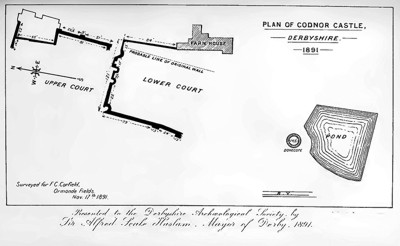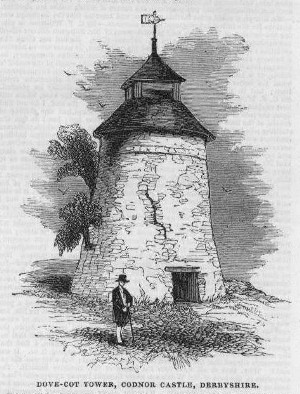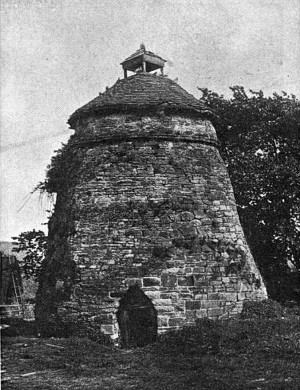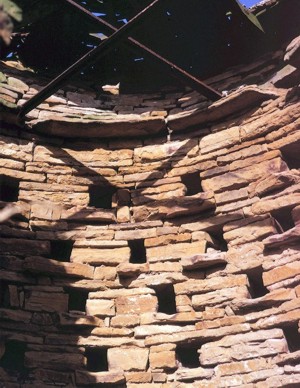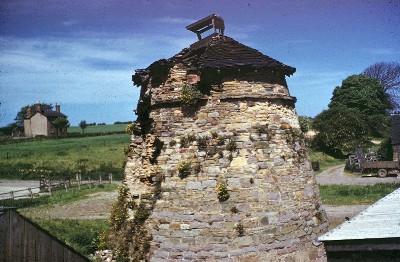
Dovecote
For hundreds of years the dovecote stood in the grounds of castle farm. Some historians initially believed the dovecote to date to the 17th century, suggesting that like the farmhouse it had been built from stone taken from the ruins of the castle.
However it is now believed that the dovecote was built much earlier and was a 14th or 15th century addition to the castle.
Pigeons provided eggs and meat for the medieval diet, but because they ate the crops, only the lord of the manor was allowed to keep them. A dovecote was also a sign of wealth.
Fig.1 Location of the dovecote in relation to the castle and farm buildings.
Drawn by Sir Alfred Seale Haslam, Mayor of Derby 1891
Displayed courtesy of the Derbyshire Archaeological Society
The building was conical in shape and rose to a height of about 22 feet, being capped with a slated roof and wooden lantern to allow access for the birds.
Its walls were made of quarried sandstone like the castle, and were approximately 5ft thick at the base.
It was constructed using a lime mortar that contained particles of charcoal, a technique that was common with Norman builders. The interior was different in that a soil mortar was used between the stones.
Inside were twenty rows of nesting holes built in to the wall, approximately 400 in total, each with a stone ledge for the birds to land on.
A small 3ft 6in door in the north side allowed access to the interior, which was lit by one small window in the south side.
Fig.2 A sketch of the Dovecote as it appeared in the
Illustrated London News 1844.
The Illustrated London News 20th July 1844
This is the ancient Dovecote of Codnor an ordinary observer would pass
it heedlessly, and number it in his note-book with those towers and
walls of the castle devoted to military purposes, and thus lose an instructive opportunity of making himself acquainted with an interesting feature of the private, every-day life of the early founders and inhabitants of this place.
Many thanks to www.jacksdale.org.uk for the above article.
The dovecote was restored and re-roofed in 1904 and a stone built into the rear of the building had the letters REP testifying to this.
Fig.3 The Dovecote a few years after its restoration. Photograph taken approx 1910.
An iron ladder existed inside when the above photograph was taken, but this may have replaced an earlier wooden ladder.
The Ripley & Heanor News, Friday 2nd October 1931
Dovecote Prisoner
Martin Beardall, of Stoneyford, was charged with being found in a
Dovecote belonging to Richard Henry Holmes, at Codnor Park, for an unlawful purpose on Sept 22nd.
Richard Henry Holmes, Castle farm Codnor Park, said about 12.30
midnight on the 26th, he heard a noise of someone shouting in the
yard. He got out of bed and went into the yard, and the noise appeared
to come from the Dovecote, where he kept about 40 pigeons. He immediately went for a constable.
P.c. Heath said he went to the premises and upon arrival heard
someone in the Dovecote, which was conical in shape and had a
wooden door and a window about 12ft from the ground.
He unlocked the door and found defendant inside. He said he had
dropped in through the window and had injured his wrist.
Defendant had gained access by climbing up to the window, which
was about 12ft from the ground, and had then had an extra drop of
3ft inside, making 15ft altogether, which prevented him reaching the window to free himself. There were two rows of barbed wire and a
wooden fence, which defendant had to negotiate before getting to the Dovecote.
Giving evidence, defendant said he had been to Jacksdale and had
taken a pint too much, and on purpose to miss the canal side he went
by Castle farm. He went on the old ruins of the castle and started to
get over the fence, and climbed the building until he got to the hole
in the wall, and must have overbalanced and fell in.
Supt. Walker: You didn’t expect to have such a drop: - No.
Fined 20/-
Many thanks to www.jacksdale.org.uk for the above article.
Fig.4 The interior of the Dovecote showing some of the 400 nesting holes.
Photographed in the 1960s by George Eyre.
Displayed courtesy of the George Eyre Collection.
By the mid 1960s the Dovecote had again fallen into disrepair and many thought the building should be demolished.
The following article appeared in a local newspaper in April 1965
No Action on old dovecote
The Butterley Co. Ltd propose to demolish the old dovecote at Codnor
and the ruins of the 13th century Codnor Castle, members of Heanor
Urban Council Finance committee heard last night. A letter from the
County Planning Officer said the company had given two months notice
of their intentions. Concern had been expressed regarding the safety
of the buildings. The planning officer said it was felt that no action
should be taken regarding the dovecote, but the castle ruin should be preserved.
Preservation Order
Mr P.M. Robinson (Clerk) said that the council could request that a
building preservation order could be made, but if the county did this,
the owners could apply for compensation. Several members said that
the building should be preserved, but thought that the dovecote, which councillor T. Harrington said was “literally dropping to pieces” was
beyond preservation. Councillor S Mellors said the ruins were an
eyesore and a danger to children. The council should send a deputation
to inspect them. Councillor W. Belfield said that if it was possible to
repair the dovecote, it should be done. It was of architectural value
and one of the few of its kind remaining in the country.
Preserve Castle
It was agreed to recommend that the county planning officer be
informed that the council wish the castle ruins to be preserved.
It was pointed out that the council had previously agreed to take no
action about the dovecote. The castle ruins are scheduled as an
ancient monument and like the dovecote, as having special architectural
or historical interest. The dovecote has a Norman wall but historians believe that the building as a whole is not contemporary with the 13th century castle, but dates from the 17th century, when the farm
adjoining was built from the stone of the ruined castle.
Fig.5 The Dovecote photographed by George Eyre in the 1960s
Displayed courtesy of the George Eyre Collection
Later in 1968 the dovecote was severely damaged by a farm tractor and in 1969 the decision was made to demolish the building.
The following article appeared in a local newspaper in April 1969
Codnor Castle Dovecote Demolished
Dispute over age
With the recent demolition of the dovecote at Codnor Castle, a controversial link with the past has vanished for all time.
During the past year, the dovecote was discussed by Heanor Council
and other local councils, but apart from the indefatigable Councillor
Billy Belfield, nobody seemed interested with this unique link with past history.
George Eyre Collection
Many more images from the George Eyre collection can be viewed at the Codnor Castle Heritage Trust's website
Information for this page was obtained from the following sources.
The Illustrated London News. July 1844
The Ripley & Heanor News. October 1931
The Ripley & Heanor News. April 1965
The Ripley & Heanor News. April 1969
Journal 14 of the Derbyshire Archaeological & Natural History Society 1892 C.Kerry.
Codnor Castle & The Greys of Codnor, B.E. Meek 2002
